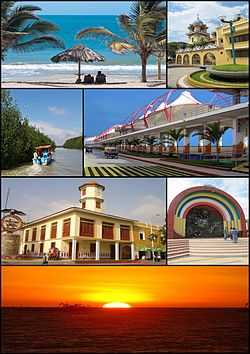Tumbes, Peru
| Tumbes | |||
|---|---|---|---|
| Town | |||
 | |||
| |||
 Tumbes | |||
| Coordinates: 3°34′S 80°27′W / 3.567°S 80.450°W | |||
| Country |
| ||
| Region | Tumbes Region | ||
| Province | Tumbes Province | ||
| District | Tumbes District | ||
| Demonym | Tambesino(a) | ||
| Founded | 1532 | ||
| Government | |||
| • Mayor | Ventora Cruz | ||
| Elevation | 6 m (20 ft) | ||
| Population | |||
| • Total | 94,702 | ||
Tumbes is a city in northwestern Peru, on the banks of the Tumbes River. It is the capital of the Tumbes Region, as well as of Tumbes Province and Tumbes District. Located near the border with Ecuador, Tumbes has 94,702 inhabitants. It is served by the Cap. FAP Pedro Canga Rodriguez Airport.
History

Tumbes has its origins back in pre-Inca times when it was inhabited by a cultural group of natives called Tumpis. At its peak, its population is estimated to have reached 178,000. After 1400, Inca Pachacuti ruled over Tumbes and the territory became an important political stronghold during the Inca Empire. Later Inca emperor Huayna Capac expanded Tumbes by ordering the construction of roads, houses and palaces.
Spanish invasion
Tumbes was first visited by Spanish conquistador Francisco Pizarro during the start of the Spanish conquest of the Inca Empire in 1528. Pizarro made a second expedition in 1532 during which he encountered resistance from the curaca (chieftain) Chilimaza in what became known as the Battle of the Manglares. Pizarro was eventually successful and is said to have planted a cross in the invaded territory as a sign of Hispanic victory. Felipillo and Yacané, the first South American Indigenous interpreters who later aided Pizarro and his followers during the conquest of Peru, were born in Tumbes.
Colony and independence
During its colonial period, Tumbes was sparsely populated and formed a part of the Audiencia of Quito through an unmodified Cedula of 1563 and Cedula of 1740. When Tumbes declared its independence from Spain it opted to join Peru believing in the right of free determination of peoples. First, the Republic of the Gran Colombia challenged that right and then Ecuador claiming de jure rights through unmodified colonial Royal Decrees ( Real Cédulas ), but to no avail. The Protocol of Rio de Janerio signed in 1942 with Ecuador legally confirmed Peru's previously de facto rights over Tumbes after a victorious war. However, lasting peace between both countries was not achieved until 1998, after a final conflict in 1995. Peruvian President Alberto Fujimori and Ecuadorian Presidente Jamil Mahuad signed a final document in which Ecuador accepted Perú's right over Tumbes and other territories claimed by Ecuador until then.

Geography
Climate
The city has a warm semi-arid climate, with an average annual precipitation of 258.2 mm (10.17 in).
| Tumbes | ||||||||||||||||||||||||||||||||||||||||||||||||||||||||||||
|---|---|---|---|---|---|---|---|---|---|---|---|---|---|---|---|---|---|---|---|---|---|---|---|---|---|---|---|---|---|---|---|---|---|---|---|---|---|---|---|---|---|---|---|---|---|---|---|---|---|---|---|---|---|---|---|---|---|---|---|---|
| Climate chart (explanation) | ||||||||||||||||||||||||||||||||||||||||||||||||||||||||||||
| ||||||||||||||||||||||||||||||||||||||||||||||||||||||||||||
| ||||||||||||||||||||||||||||||||||||||||||||||||||||||||||||
Coordinates: 3°34′S 80°27′W / 3.567°S 80.450°W

